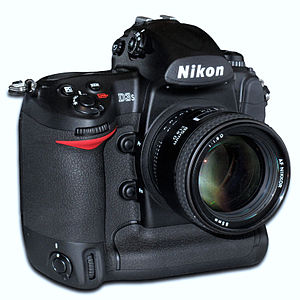D3s
 |
|
| Overview | |
|---|---|
| Type | Digital single-lens reflex camera |
| Lens | |
| Lens | Interchangeable, Nikon F-mount |
| Sensor/Medium | |
| Sensor | 36.0 mm × 23.9 mm CMOS, Nikon FX format |
| Maximum resolution | 12.1 effective megapixels (4,256 × 2,832 pixels) |
| ASA/ISO range | ISO equivalency 200 to 12800 in 1/3, 1/2 or 1.0 EV steps, Boost: 100–102400 in 1/3, 1/2 or 1.0 EV steps |
| Storage | Two CompactFlash (Type I) card slots |
| Focusing | |
| Focus modes | Single-servo AF (S), Continuous-servo AF (C), Manual |
| Focus areas | 51-area Nikon Multi-CAM 3500FX |
| Focus bracketing | none |
| Exposure/Metering | |
| Exposure modes | Programmed Auto [P], Shutter-Priority Auto [S], Aperture-Priority Auto [A], Manual [M] |
| Exposure metering | TTL full aperture exposure metering system |
| Metering modes | 1,005-pixel RGB 3D Color Matrix Metering II, Variable Center-Weighted, Spot AF |
| Flash | |
| Flash | n/a |
| Flash bracketing | 2-9 frames in steps of 1/3, 1/2, 2/3 or 1 EV |
| Shutter | |
| Shutter | Electronically controlled vertical-travel focal-plane shutter |
| Shutter speed range | 30 to 1/8000 second and bulb |
| Continuous shooting | 9 frame/s (11 frame/s in DX crop mode) |
| Viewfinder | |
| Viewfinder | Optical-type fixed eye level pentaprism |
| Image Processing | |
| Custom WB | Auto, Presets (5), Manual, and Color temperature in Kelvin |
| WB bracketing | 2 to 9 frames, 10,20,30 MIRED steps |
| General | |
| Rear LCD monitor | 3-inch diagonal, 307,000 pixels (920,000 dots), TFT VGA |
| Battery | Li-ion EN-EL4a |
| Optional battery packs | EH-6 AC Adapter |
| Weight | 1,240 g (2.73 lb) |
| Made in | Japan |
The Nikon D3S is a 12.1-megapixel professional-grade full frame (35mm) digital single-lens reflex camera (DSLR) announced by Nikon Corporation on 14 October 2009. The D3S is the fourth camera in Nikon's line to feature a full-frame sensor, following the D3, D700 and D3X. It is also Nikon's first full-frame camera to feature HD (720p/30) video recording. While it retains the same number of pixels as its predecessor, the imaging sensor has been completely redesigned. Nikon claims improved ultra-high image sensor sensitivity with up to ISO 102400, HD movie capability for extremely low-lit situations, image sensor cleaning, optimized workflow speed, improved autofocus and metering, enhanced built-in RAW processor, quiet shutter-release mode, up to 4,200 frames per battery charge and other changes compared with the D3. It was replaced by the D4 as Nikon's high speed flagship DSLR.
Many independent reviews and comparisons show that image noise was improved up to 2 stops compared to the Nikon D3 or D700. Other functions, especially autofocus and speed, support this, causing PhotographyBlog to conclude: “hand-held photography anytime, anywhere, without flash”. There are comparisons with the Canon EOS-1D Mark IV, which is rated 1.3 stops lower by DxOMark on their low-light ISO score (1320 ISO vs. 3253 ISO for the D3s).
Low-noise videos are valuated useful. While not officially documented in user's manual, D3s indeed features the full manual control in D-Movie mode, including aperture, shutter speed and ISO. This feature was reported and posted by various users and eventually confirmed officially.
On 21 December 2009, Nikon announced that NASA had purchased 11 D3s bodies and assorted lenses for use in the United States space program, including on the International Space Station. The D3s cameras are identical to the model sold to terrestrial users and will be used unmodified.
...
Wikipedia
